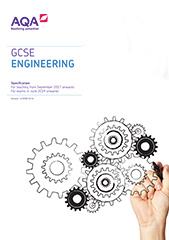3.3 Systems
Students should have knowledge and understanding of the use and role of the following systems within engineering settings. Students should be:
- familiar with the function of the system building blocks specified in 'systems' below
- able to describe the way in which parts of a system can be divided into sub-systems.
Subject content |
Additional information |
Mathematical understanding |
|---|---|---|
Systems descriptions |
|
M1.3, M2.4 |
Mechanical systems
Subject content |
Additional information |
Mathematical understanding |
|---|---|---|
|
E14, E15 |
|
|
Ratio of simple gears and mechanical advantage |
|
| Pulleys (how pulleys can be used as a means of reducing effort when lofting loads or transferring power within a system). | M1.4, M3.2, M3.3 |
|
| Bearings. |
Electrical systems
Subject content |
Additional information |
Mathematical understanding |
|---|---|---|
|
Electrical systems comprising:
The difference between Alternating and Direct Current. |
M3.2, M3.3, M3.4, M4.1, M4.5 E12 |
Electronic systems
Subject content |
Additional information |
Mathematical understanding |
|---|---|---|
|
Electronic systems comprising:
|
||
| Programmable devices: microcontrollers eg peripheral interface controller (PIC) used to perform more complex operations or replace discrete process integrated circuits. | M3.1, M3.2 |
|
| Interfacing components: drivers required for loads that process or programmable devices cannot supply (transistor, field-effect transistor (FET)). | ||
| The use of analogue to digital conversion (ADC) in a programmable device. | ||
Output components
|
||
Discrete components within a circuit:
|
E12, E13, M2.1, M2.3 |
|
| Simple programming for monitoring and controlling processes: using flow charts for explanation, limited to three inputs and three outputs within an engineered system eg a pick and place machine used in the production of electronic circuits. |
Structural systems
Subject content |
Additional information |
Mathematical understanding |
|---|---|---|
| Students should know how simple imposed, dynamic (live) and static (dead) loads are applied and transmitted, including space frame and monocoque structures, leading to bending and torsion/buckling. | E11 |
Pneumatic systems
Subject content |
Additional information |
Mathematical understanding |
|---|---|---|
The uses of and differences between pneumatic and hydraulic circuits. Exam questions may focus on the specific circuits and students may be expected to provide an example of when the different types of circuits could be used and why. Examples include:
|
E10 |
